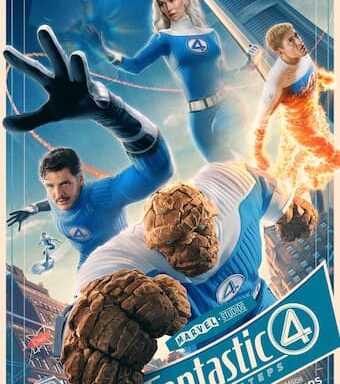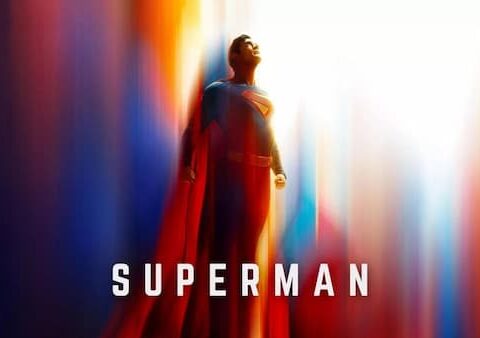So, here’s the full series review for Civil War II – a nine-book event that rocked the Marvel Universe for a good while.
A series that fell short of being perfect – but which, I assert, is better than the original Civil War storyline from 2006.
As usual, I’ll run through my notes for each issue in the series and then finish with a general overview of the whole run.
Civil War II #0 leads us in, with a bad-ass cover. There isn’t much to note about it apart from that. The Carol/Doc Samson talk about the “illusion of control” is fairly interesting; but this chapter is basically just scene-setting for the series proper to start.
Civil War #1 gets things going properly, with a big, MU-family battle against a horde of Celestial invaders. This is actually a really good, fun sequence, beginning with the (current) Avengers line-up led by Tony Stark and then bringing in much of the MU.
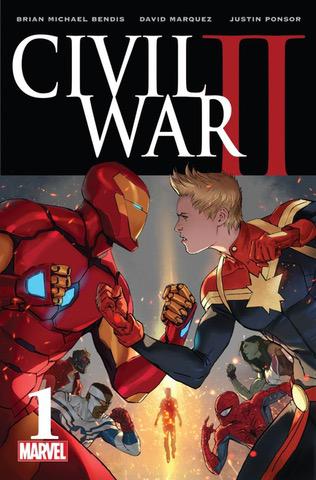
It’s a good, solid dose of big-scale comic-book action, aided substantially by David Marquez’s flawless renderings and Justin Ponsor’s vivid colors.
What this book does particularly well is making suitable space for characters: even in the battle sequence, special space is given to the ‘magicians’ (Doc Strange, Wanda, Magik/Illyana, etc) being put to strategic use in the operation. But the best example of this is having Jean Grey specifically brought in to act as a conduit for the psychic Ulysses – which is a particularly nice writing choice, utilising a suitable character for a specific purpose.
In general, characters are well written and well accounted for – from Carol and Stark to Steve Rogers and Spiderman.
The centerpiece of this issue is the first big discussion about the Inhuman Ulysses and his visions; a discussion that involves a number of major MU characters, including Inhumans. It centers, however, around Carol and Tony, establishing the clear moral divide that underscores the entire series.
Carol sees Ulysses’ premonitions as a tool that enables heroes to act to prevent crises or tragedies before they materialise: while Tony objects to the idea of using these visions of ‘possible futures’ as a justification for trying to change the future and ‘play God’.
I’ve seen some criticisms going around about this general premise: but I genuinely like it. While it isn’t as meaty as the moral divide that characterised the original Civil War storyline, it’s still interesting enough to be engaging.
Also, aside from being an engaging flashpoint in conceptual terms (touching, as it does, on questions about predestination and paradoxes), it also – like the original Civil War – can be said to somewhat reflect real-world issues.
While the divide in the first Civil War deliberately touched on the Patriot Act and the general post-9/11 quagmire, this time we’re dealing (albeit less obviously) with the idea of pre-emptive strike and pre-emptive criminalisation – a theme that becomes more obvious as the series goes on and which threfore touches somewhat on the idea of racial profiling, for example, or generally of punishing ‘would-be’ criminals for things they haven’t done yet.
In Civil War II #2, for example, Tony makes this more singificant by asking Ulysses whether his visions of future events are influenced by his own biases, be they political, racial, sexual or anything else. In Civil War II #4, he goes further and identifies Carol’s actions as “profiling”, complaining that “free will is being eliminated from the process of choice”.
Having Stark and Danvers specifically be the principal characters through which the story is told was always a sound choice. It is also gratifying to see Captain Marvel being afforded such a big, central role in the event: and it really does illustrate how far the character has come (in terms of profile, prominence and popularity) in even the ten years since the original Civil War event.
If there’s one problem I have with this set-up, it is the fact that – as the series progresses – Carol’s position becomes less and less believable.
It isn’t a problem here in Civil War #1 at all, but specifically a problem that unfolds as things move forward. As far as Civil War #1 goes, the Carol/Tony material is genuinely engaging and meaningful. It is also entirely believable that Carol – exicted by the potentiality that Ulysses presents – would go off on a pre-emptive strike. The fact that it goes very badly and has massive costs establishes the fall-out that drives the rest of this conflict.
Danvers and Stark are both very well written throughout Civil War #1 and this is generally a well-told story.
The color and tones in some of these pages is superb: for example, there’s a particular panel on page 24 where the light is rendered vividly on Tony Stark while the rest of the characters in the panel are in relative dimness. Also, curiously, the image of Carol cradling Rhodes appears to deliberately foreshadow the image that appears multiple times later in the series of Miles Morales and Steve Rogers – which is an interesting choice.
Civil War II #2 opens with Stark violating New Attilan in an attempt to kidnap Ulysses.
This results immediately in a confrontation with Medusa, which is fairly compelling in its impact on MU politics: specifically, in this case, Iron Man’s violation of Inhuman territory.
This idiosyncratic MU politics – along with the accompanying tapestry of inter-character dynamics – is always one of the best things about larger-scale Marvel stories, as is very much the case here. There are so many smaller connections or micro-elements in play, sometimes via only a single line or reaction. Case in point: Hank McCoy’s “I don’t fight Tony Stark” (in response to being asked why he doesn’t help defend New Atillan against Stark’s violation) is interesting.
A particularly resonant image opens the book, by the way, showing New Attilan across from the Statue of Liberty and a large, full moon.
The art, again, is absolutely first-rate, along with the colors. Some of these characters in this series are being rendered here – Medusa, Crystal, Stark, Danvers, etc – as perfectly as I’ve ever seen them.
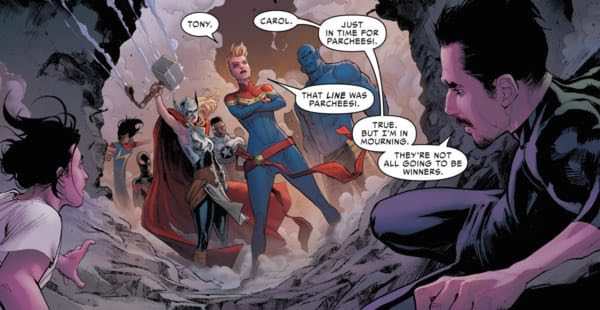
The big showdown between multiple characters and factions – which occurs repeatedly throughout this series – is still engaging at this point: and still beautifully rendered too, with color and perspective giving us some of the best eye-candy comic books can offer. In this instance, we have a three-way altercation, with Medusa and the Inhumans on one side, Carol and her people on another, and Stark more or less standing on his own.
It’s all good stuff: but before the matter can either be resolved or escalate further into a brawl, Ulysses has another vision (that he shares with all those gathered), this time of the Hulk going on the rampage.
Civil War II #3 opens with Carol and Tony visiting Banner to try to figure out if Ulysses’ vision might be true.
And this opening sequence is genuinely uncomfortable – which is testament to how well written and well conceived this early half of the Civil War II storyline is.
And it is uncomfortable: knowing that Banner hasn’t *done* anything yet and knowing that Carol and Tony are both his friends, but that they’ve intruded on him like cops coming to investigate a crime suspect. And this scene gets to the heart of why I maintain this was a very good premise for a Civil War II event, with a lot of interesting potential.
When Banner steps out and finds himself under the scrutiny of what looks like most of the Marvel Universe (again, the colors and renderings are just superb), the tension grows. This tension is quickly and abruptly pierced by Hawkeye who puts Banner out of commission before he can get angry enough to be a problem.
This is all rich, tense plotting, enlivened by strong characterisation and interplay. What’s also particularly standout about Civil War II #3 is its narrative structure, with the events being relayed to us in flashback and multiple/alternating perspectives in the form of Hawkeye’s trial.
It’s a great narrative trick that means we get the story a bit at a time and from multiple perspectives.
It also means, in keeping with this series’ excellent utilisation of multiple, diverse MU characters, that we get a Matt Murdock appearance in the court room. On that note, one of the particular details I loved here was the single-panel image of the X-Men at home, tensely watching the trial on TV (page 22): it’s a lovely little touch that was both unnecessary and pleasing.
On the same note – and these are the kinds of little details I really love in a Marvel comic-book – is the later, larger single-panel image of Miles Morales web-slinging across the skyline and pausing to notice billboard footage of Danvers giving evidence in the trial.
Again, it’s unnecessary, but it’s a great way to keep everyone involved in what’s going on and to convey the scope of the events.
Again, the tension and conflict between Stark and Danvers is genuinely interesting, genuinely well written (and again, beautifully rendered visually): an ideological divide between two people who both think they’re doing what’s right.
Seeing this tension play out among the onlookers is interesting too, although we get much more of that as the series progresses. Here, it’s interesting that the three youngsters – Nova, Ms Marvel and Miles Morales – all seem to agree with Stark’s position: but I like that the three of them only say this very quietly and only to each other.
Again, it’s nice, subtle characterisation. Miles’s awkward, impotent “this is nuts” appropriately sums up the situation: but it also conveys the youngsters’ somewhat helpless, bystander status quite effectively as they watch the grown-ups coming apart.
We’re four issues into the main Civil War II series by now – and it’s all strong, engaging, absorbing stuff so far. It has also all been visually superb – David Marquez’s illustrations and Justin Ponsor’s colors keep the action in every issue flowing perfectly, leaving no point (not a single panel that I can think of) in which the experience is halted by a bad rendering or awkward visual.
Whether it’s big moments or the quiet, subtle moments, it’s all captured perfectly. There’s an image, in Civil War II #4, of Carol and some of the Inhumans approaching the street from above, with the skyline and the lens-flare/sun behind them – and it’s just stunning (it’s actually too small for an image that good and should’ve been a whole page).
So onto Civil War II #4.
And there’s a great juxtaposition here of having Stark outlining everything that’s wrong with Carol’s “profiling” policy and the reliance on Ulysses’ visions, while we’re also watching a scene of Carol and her team swooping into a city building to arrest someone based purely on one of the premonitions.
What works particularly well here – aside from the interesting and logical observations Stark is making – is that it becomes uncomfortable watching Carol carry out this arrest. For one of the very few times I can remember in recent memory, Carol Danvers now actually does seem like the Bad Guy – like the one who’s gone completely off the track.
Speaking as someone who’s been a massive fan of this character for some years now, this is a troubling scene to read, as she basically seems like a Bad Cop abusing her powers – even though this isn’t exactly an accurate depiction of the situation.
Up to this point in the series, the depiction of Carol is still very layered and interesting: it later starts to diminish in quality, but we’re not quite there yet.
The next big conference between Tony, Carol and other senior heroes – including Rogers, McCoy and Medusa, among others – is just as tense and intriguing as all the previous trysts. But this time Tony has the winning hand and the more convincing argument: and Carol, sensing she is losing the justification, gets defensive and angry, literally flying off through the ceiling.
Fittingly enough, Tony does now reference the previous Civil War storyline here, which helps remind us that ten years ago it was Tony himself who was the one in the position that Carol is in now. That point isn’t acknowleged outright here, but it’s a subtle subtext.
In keeping with the ‘Carol is going off tracks’ motif, she later confirms what Tony has said about her when Maria Hill tells her that a suspect she has arrested (based on Ulysses’ visions) has shown no indication of any wrongdoing or any criminal connections: Carol’s response is basically ‘we’ll find something’.
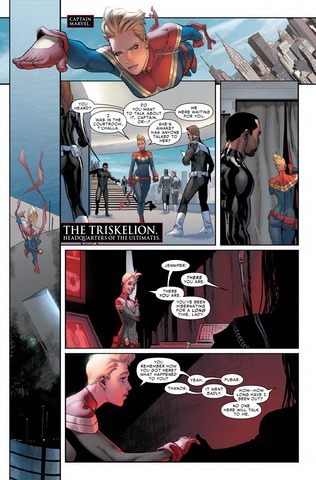
In that response, we see pretty much that Carol has given herself over completely to the infallibility of Ulysses’ visions and is unwilling to even consider that her suspect might be innocent.
When the suspect is abruptly bamfed out of the room – by Nightcrawler; which was a brilliant touch – Carol heads outside to find Tony and an army of MU heroes waiting for her. Carol has her own army of MU heroes too, however – and is soon joined by reinforcements from above in the form of the Guardians of the Galaxy.
This is perhaps the most typically (slightly childish) comic-book moment so far. But even this has some lovely little touches to it. I love that we don’t actually *see* Nightcrawler at all in the jail-break, but literally only see the puff of purplish smoke from the bamf.
Carol marching out and insisting “You’re under arrest, Tony Stark!” also makes for a cool moment; even if, again, a touch on the silly side.
The whole thing of having the two rival line-ups of ammassed superheroes facing off against each other is such a comic-book cliche by now that it makes a seasoned reader sigh a little. It’s much more interesting when the characters are all jumbled together and having little disagreements among themselves. But, for an event that was billed as basically ‘which side are you on?’, this kind of trope was inevitably being built towards.
A side-note: it really does show how complicated (and, to some, over-burdened) the MU has become when we see two rival assemblies of heroes and there’s an Iceman/Bobby Drake on *both* sides.
Civil War II #5 opens with the big, fan-boy superhero royal rumble that was set up in #4.
Brief note: Riri Williams looks like Optimus Prime – it’s not a good look.
Carol shows that she’s not entirely off-the-rails: when Tony accuses her of losing her mind to a massive, “control issue”, she pertinently accuses him of “projecting” – which isn’t a bad point, given the history. It’s a good exchange – and it shows that, despite some of the problems that emerge with this series later on, Bendis has a very good handle on both Carol and Tony and their histories.
The big plot-twist in this showdown is when Ulysses shows all of the assembled heroes a vision of Miles Morales killing Captain America. The image, by the way, of Morales holding Rogers’ dead body – which appears multiple times in what remains of the series – is a very strong one.
What works brilliantly here – and is a credit to Bendis’s handle on characters – is some of the smaller reactions. Miles’s baffled, horrified reaction to a vision of his own future actions is spot-on – but so is the fact that it is Kamala who runs over to him to support him.
A brief, wordless exchange between Carol and Kamala is also a perfect detail – the two of them have no real interaction in this series, but just having them have a moment here means something. Some writers do often tend to neglect or overlook existing connections between characters when a big overlapping event is going on; but Bendis frequently shows here that he doesn’t have that problem.
It’s great also to see a number of my very favorite characters – Nightcrawler (previous issue), Magik, T’Challa – not only show up, but have (even small) meaningful moments. Magik, for example, gets a bad-ass moment where she totally gets one over on Sam Wilson.
There’s some really nice attention to detail here as well. On page 17, for example, we see Starlord and Iron Man having a heated argument about Carol in the foreground, while in the background we’re still seeing a fight going on between Vision and Kitty Pryde. While Tony and Peter are still talking, we can see Vision shoot an optic beam at Kitty, but she phases and it passes through her, unintentionally meaning it is now on a trajectory towards the Guardians’ ship.
Stark and Quill are still talking when, on the next page, we see the ship blow up from the blast.
Attention to detail like this – managing multiple elements even within the same panel – makes the action feel that much more cinematic and three-dimensional.
Civil War II #6 opens with the entire panoply of characters gathered around a crestfallen Miles Morales and trying to decide what to do about the vision they’ve just had of him killing Captain America.
This scene here is the very finest scene so far in the storyline. The tension, again, is palpable, and the clashing positions are all entirely believable.
Miles is utterly heartbroken and confused. This time it’s Nova’s turn to say “This is nuts!” And then inevitably Carol and Tony clash over what to do. She wants to take Miles into custody – Tony objects passionately.
In fact, Tony’s plain defense of Miles is possibly the most genuinely sympathetic Stark has come across to me in a long time. Yet, at the same time, some of what he throws at Carol would be classed as deliberately hurtful – if not for the fact that it has truth to it. “You’re turning on children now,” is particularly cutting.
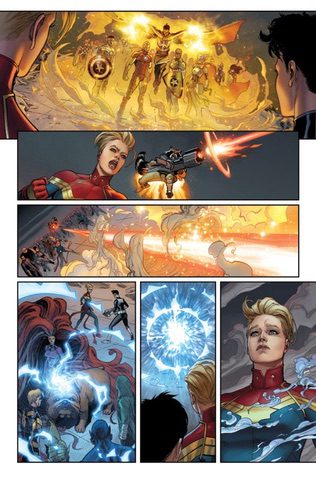
But Carol’s “stop demonising me for being pro-active” is also a perfectly logical response – which, again, is testament to how well-written both characters are at this time. Their positions are both understandable.
Bendis’s handle on character dynamics continues, panel by panel and page by page. Steve Rogers’ sensitive, sympathetic intervention to get Miles away from this situation is, again, just a perfect Captain America moment (even though it becomes problematic when we factor in what’s actually going on with Rogers outside of this story – but I’m willing to overlook that here).
And then Kamala Khan intervening physically to stop Carol going after Miles is also, again, a perfect understanding of character connections.
The images of Thor carrying Morales to safety are stunningly rendered, even by the standards of this series. In particular, the image of Miles on a rooftop, breaking down into despair, with the night-time city skyline behind him, is totally sublime.
This really is Marvel big-scale storytelling at its best across-the-board: art and color, perspective and scope, characterisation and writing, all of it flourishing at a high level.
The superb attention to characters continues. When Carol – who has just seen most of her friends and allies (including even T’Challa at this point) turn against her position – has a quiet moment with Starlord, she is expecting him to lecture her on her actions. Instead she is surprised when he supports her fully: the way this is rendered conveys she’s even a little emotional about it, as though relieved to finally have someone taking her side.
But even better is what’s going on on the Stark side of things. While Tony, T’Challa, Rogers and the other grown-ups are discussing what to do, Kamala, Nova and the other junior heroes quietly decide to go off on their own to try to find and protect Miles.
Firstly, this quiet little story element – the idea of the kids sticking together and showing loyalty to their absent, troubled friend – is rather precious. Secondly, it’s particularly great to see Kamala take the lead among those characters, which at this point also includes the young Cyclops.
But thirdly, Stark’s reaction to it is utterly golden. When Cap asks him where the kids are going, Tony knows instinctively that they’re “sneaking off to find their friend… to protect him from all us”. But better yet is him not being sure whether to “be annoyed or proud of them”. It’s a genuinely endearing moment that isn’t lingered on by Bendis, but nevertheless again shows his respect and understanding towards multiple characters and their connections.
That’s the strongest selling point of this entire series, and of Civil War II #6 in particular.
We go then to Civil War II #7 – the penultimate installment. And it is probably the first issue of the main title that slips just a little in quality.
Not too much though.
The Miles Morales and Captain America encounter on the Capitol steps – bringing them dangerously close to fulfilling the vision Ulysses had previously shown them – is, again, nicely characterised, with each of them trying to understand and respect the other and neither harbouring any hostility.
Carol’s arrival on the scene doesn’t break the flow of well-realised characterisation. Her observation about everyone always expecting the worst of her these days is less sarcasm and more plain fact; and her asking Cap to tell Miles that she isn’t “Satan” (which Cap obligingly does) is a nice little moment before the shit hits the fan again with Iron Man’s gate-crashing antics.
Stark shows up in his mega Hulk-buster armour or whatever it is. It’s another one of those unappealing, childish comic-book moments. I can get the logic of why it’s there – but it does soemwhat detract from the sublety of the preceding interactions.
This time there’s no real ideological debate or meaningful dialogue, just a big-ass Iron Man vs Captain Marvel comic-book fight in the sky, which takes us directly into the final issue.
It’s a little low-grade for the final cliffhanger, especially given some of the terrific character work and ideological debate that has raised the level of previous installments in the title.
And, as we head into the finale, we of course are fully prepped for the likelihood of a disappointing, anti-climactic conclusion to the storyline, as is usually the way of big event stories.
Civil War II #8 isn’t a total dud; but it is entirely anti-climactic and doesn’t live up to the quality in much of the build-up.
The big final showdown between Danvers and Stark lacks any real interest; though, as with the entire series, it is beautifully rendered and coloured. Every image and panel seems to glisten and pulse. Carol in particular has rarely been rendered this perfectly, so much so that it feels like a definitive image of Carol Danvers.

Story-wise, this was all spoilt in advance for most people (the cover also gives it away); besides, this whole title has centered on the Stark/Danvers fall-out, so it was always going to end on this too.
My biggest problem with this – and it is also my problem with the latter half of the series – is that it just stops feeling like a legitimate characterisation of Carol Danvers.
Captain Marvel has been one of my favorite comic-book characters for some time (since at least the point where Kelly Sue DeConnick was writing her) and I feel like I have a pretty good handle on her – and there comes a point in this storyline where it feels like she has been taken a touch too far beyond what her character really is.
It’s a matter of opinion, of course – and comic-books do this all the time. But I don’t feel that Carol would go this far with Tony.
She’d fight him, sure. I just don’t buy that she would take it as far as she does here: especially not in the pursuit of a cause that she surely *knows* is ethically questionable.
Just doesn’t fit right with the Carol Danvers we know. As good as Bendis’s writing in this title has been – and as well as Carol was written for much of the storyline – this is where it really stops ringing true. I just don’t buy that she would end it like she does here. And that’s a fairly big problem with the story, as this is essentially the moment the entire series has been building up to.
The other problem with Civil War II #8 is how much of it falls into the comic-book cliche of acting as an extended advert for other comics and stories to come.
It does this twice: first with the big, over-drawn sequence of images showing us upcoming books (via the plot-device of Ulysses’s visions of the future), and then again at the end when Carol is speaking to President Obama. In the first instance particularly, this is just so over-done and goes on for so long that it becomes an annoying break in the narrative.
There’s literally several full pages of these shameless promos for upcoming (and entirely unrelated) stories – taking up space in what is supposed to be the finale to a massive storyline.
This just feels off-key on a number of levels: the worst of them being the sense that they couldn’t even bother finishing up this storyline properly without using it to plug the next several events.
As I said, Civil War II #8 isn’t all bad. There’s good stuff in it; but it is probably the weakest of all eight issues in this central title.
Henry McCoy’s dialogue with Carol at the end is probably the best thing in this finale.
The whole “he wasn’t fighting you, you know” conversation does wrap things up fairly nicely, even if most of the preceding action doesn’t. Hank’s reading of Stark’s motivations is also very strong: specifically, his understanding that Tony hadn’t been worried about Carol, but about whoever it was that would come after Carol.
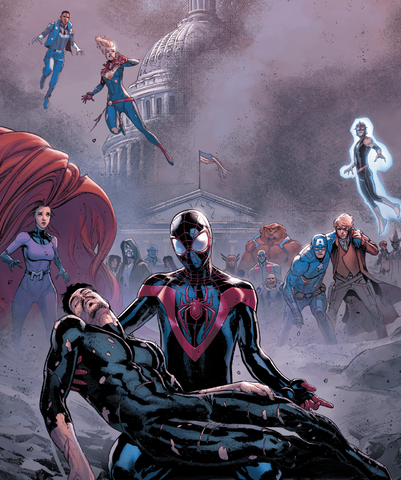
In other words, once Carol established this questionable precedent of “profiling people” (and “profiling the future”), there would eventually be someone less noble than her who would inherit those powers or means – and this is what Stark was fighting so hard against.
I like this perspective on things; partly because it is something I have thought about a lot recently in my capacities as a politics/current-affairs analyst.
Specifically that questionable or even unlawful powers or precedents put in place by even well-meaning governments or administrations can later be inherited by much more dangerous parties. I’ve specifically worried about this in regard to the ’emergency powers’ initiated in France lately by a mostly liberal, Left-leaning government – and the very real danger of the Far-Right, nationalist Front National winning the French election and inheriting these vast emergency powers for itself. Similar could be said about Bush-era and Obama-era powers being taken up by the Trump/Bannon administration.
It pleased me to see Hank raising that issue here; but, of course, this finger-on-the-pulse of contemporary political/social concerns was also rooted very much in the original Civil War storyline and its nature as a post-9/11 commentary.
All in all, this wasn’t the finale that this series deserved: but it was probably the finale we should’ve expected.
As is so often the case with the big ‘event’ storylines, most of the great material is in all of the preceding material and not in the concluding piece.
It is anti-climactic; however, the majority of the material from Civil War II #1 to #8 was genuinely of a very high standard and was thoroughly entertaining and engaging. On the balance and in the final reckoning, when judging the ‘event’ as a whole, we have to rate it according to all of the material and not just the finale.
By that measure, Civil War II is a well written saga, with some superb character work (just not in the finale), first-rate dynamics, genuine tension and engaging conflict, and interesting themes. And all of it sublimely illustrated and rendered throughout.
I was thinking about this recently and I actually have to consider that I enjoyed Civil War II more than I enjoyed the original Civil War: though, to be honest, I’m not basing this on my memory of reading it during its original run, but on a full re-reading of the entire story that I did just prior to the Captain America: Civil War film coming out.
Reading the original Civil War again, I was surprised by how much of it bored me and how much of it I skipped over (as terrific as parts of it still are, of course).
Whether the motivation for this Civil War II event was simply memorialisation of that famous story’s 10-year anniversary or whether it was meant merely to tie-in to the ‘Civil War’ brand hitting the big-screen, the only important question is whether there was a worthwhile or interesting story to tell at the same time.
I happen to think there was; and that, for about 97% of this series, that’s precisely what we got. Tripping over itself a little at the final hurdle was inevitable – that’s the Marvel way.

